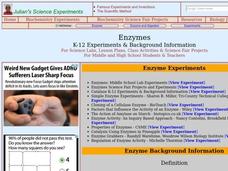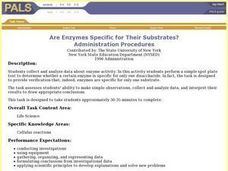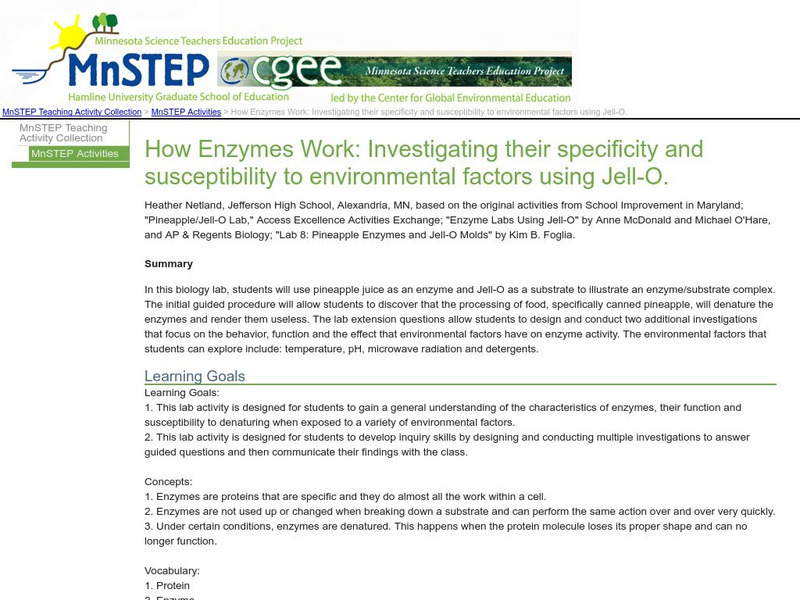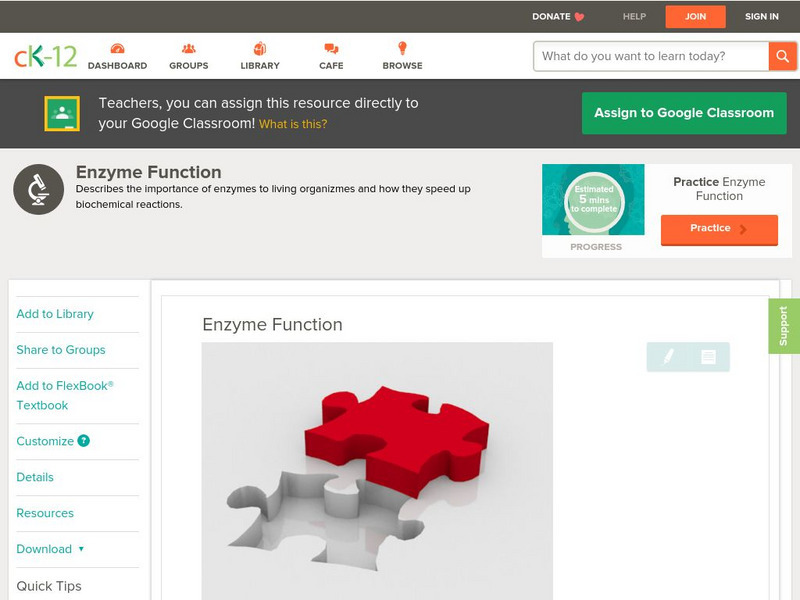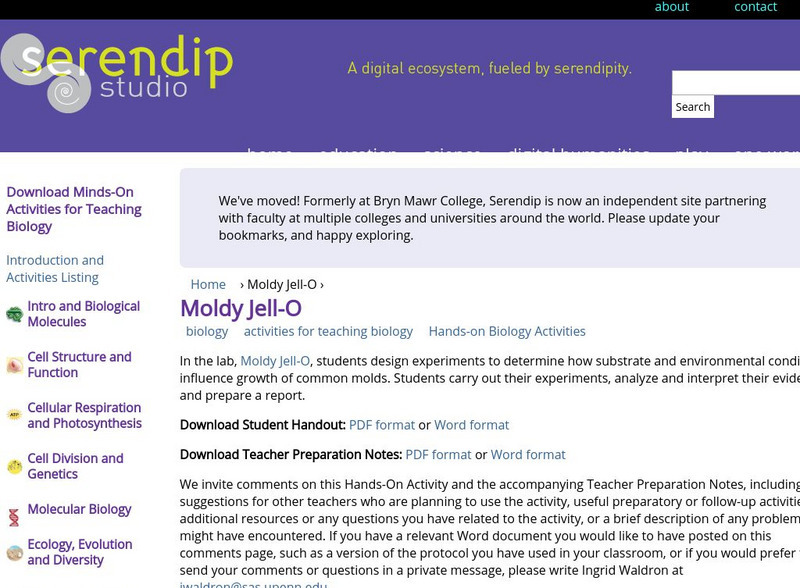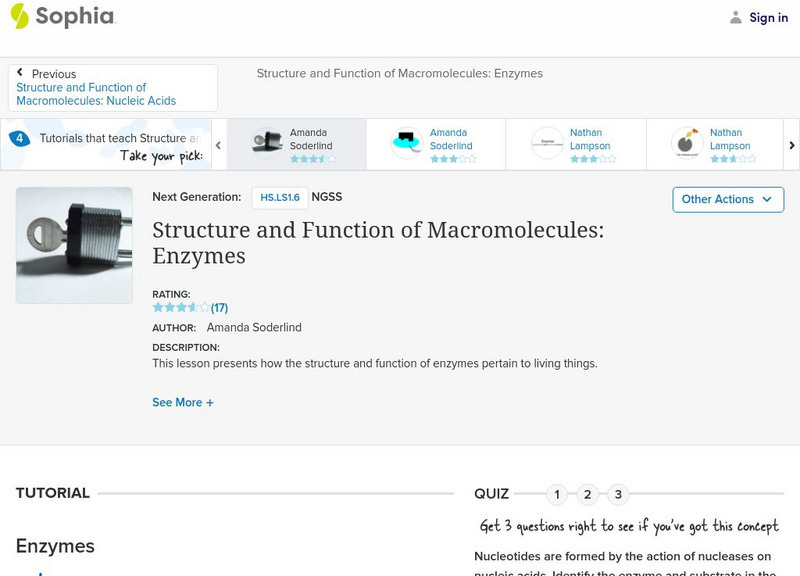Curated OER
Enzyme Practice Sheet Key
In this enzyme worksheet, students solve 6 problems including questions about how enzymes work, graphs of the relationship between enzyme and substrate and structures of enzymes.
Curated OER
Enzymes
Students explore enzymes and what can inhibit and act as a catalyst for them. In this enzymes lesson students complete experiments on enzyme properties.
Curated OER
Living in Extreme Environments
Students examine the characteristics of the ocean floor and the importance of of extreme environments. In this investigative lesson students use four methods to sample populations, gather, record and analyze data from a scientific...
Curated OER
Are Enzymes Specific for Their Substrates?
High schoolers discover enzyme to substrate specificity. The experiment uses samples of glucose and lactose in combination with the enzyme lactase. Students observe the reaction between the lactose and the lactase; the lack of a...
Curated OER
Enzyme Activity: An Inquiry Based Approach
Using an inquiry approach to studying biochemical reactions, cooperative teams of students investigate hypotheses about living materials that contain enzymes which break down in hydrogen peroxide. They perform experiments, practice...
Curated OER
Proteins
In this biology worksheet, students identify and locate various vocabulary terms pertaining to types of proteins. There are 22 biology terms located in the word search.
Concord Consortium
Concord Consortium: Stem Resources: Molecular Self Assembly
A series of science simulations exploring how molecules assemble themselves and how scientists are learning to engineer their structure. Students will discover what patterns molecules form with interactive lessons. At the end there is a...
Other
Classroom Activities, Stories and Facts: Hydroponics
A list of stories, activities, facts and questions all pertaining to hydroponics. Includes information on building your own classroom hydroponic system.
Science Education Resource Center at Carleton College
Serc: How Enzymes Work
In this biology lab, students use pineapple juice as an enzyme, and jello as a substrate to illustrate an enzyme/substrate complex.
Sophia Learning
Sophia: Active Site: Lesson 4
This lesson shows that an active site is the space on an enzyme where a substrate would attach. It is 4 of 4 in the series titled "Active Site."
CK-12 Foundation
Ck 12: Biology: Enzyme Function
[Free Registration/Login may be required to access all resource tools.] Describes how enzymes speed up biochemical reactions.
Sophia Learning
Sophia: Enzymes Proteins That Pack a Punch!
Through a combination of slide show tutorials and a video demonstration, learn how enzymes work. [3:00]
Bryn Mawr College
Serendip: Moldy Jell O
Brief text summary of what students learn in the Moldy Jell-O Lab along with links to download Student Handouts and Teacher Preparation Notes in PDF or Word formats. Students design the experiment and observe the growth of mold. Focus is...
Sophia Learning
Sophia: Enzyme Function: Lesson 4
This lesson will describe how an enzyme is used to turn substrate into product. It is 4 of 5 in the series titled "Enzyme Function."
Sophia Learning
Sophia: Induced Fit: Lesson 2
This lesson will describe the process of induced fit, and explain how enzymes use it during chemical reactions. It is 2 of 3 in the series titled "Induced Fit."
Sophia Learning
Sophia: Induced Fit: Lesson 1
This lesson will describe the process of induced fit, and explain how enzymes use it during chemical reactions. It is 1 of 3 in the series titled "Induced Fit."
Sophia Learning
Sophia: Lock and Key Model: Lesson 2
This lesson will show that each enzyme fits to a specific structure using the lock and key model. It is 2 of 4 in the series titled "Lock and Key Model."
Sophia Learning
Sophia: Lock and Key Model: Lesson 3
This lesson will show that each enzyme fits to a specific structure using the lock and key model. It is 3 of 4 in the series titled "Lock and Key Model."
Sophia Learning
Sophia: Lock and Key Model: Lesson 4
This lesson will show that each enzyme fits to a specific structure using the lock and key model. It is 4 of 4 in the series titled "Lock and Key Model."
Sophia Learning
Sophia: Structure and Function of Macromolecules: Enzymes: Lesson 3
This lesson presents how the structure and function of enzymes pertain to living things. It is 3 of 4 in the series titled "Structure and Function of Macromolecules: Enzymes."
Sophia Learning
Sophia: Structure and Function of Macromolecules: Enzymes: Lesson 4
This lesson presents how the structure and fun#tion /f enzymes pertain to living things. It is 4 of 4 in the series titled "Structure and Function of Macromolecules: Enzymes."
Sophia Learning
Sophia: Active Site: Lesson 3
This lesson shows that an active site is the space on an enzyme where a substrate would attach. It is 3 of 4 in the series titled "Active Site."
Sophia Learning
Sophia: Activation Energy: Lesson 2
This lesson will explain how activation energy is needed to start a chemical reaction. It is 2 of 5 in the series titled "Activation Energy."
Sophia Learning
Sophia: Activation Energy: Lesson 3
This lesson will explain how activation energy is needed to start a chemical reaction. It is 3 of 5 in the series titled "Activation Energy."



